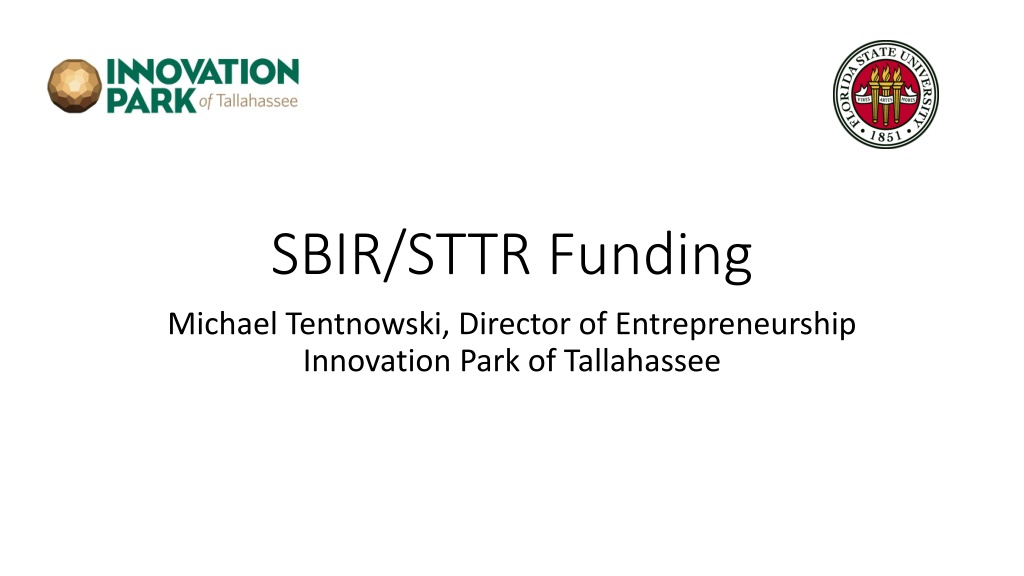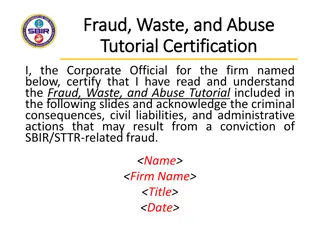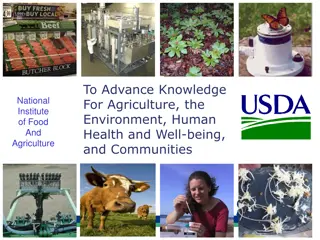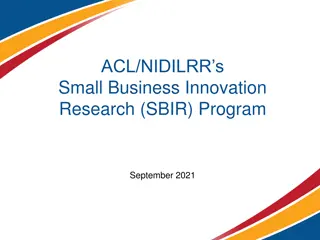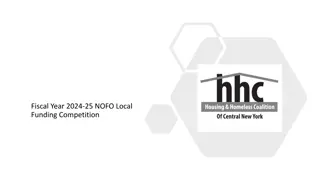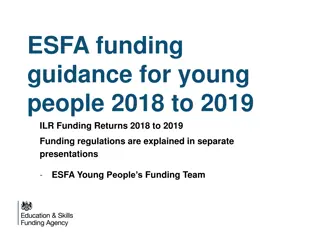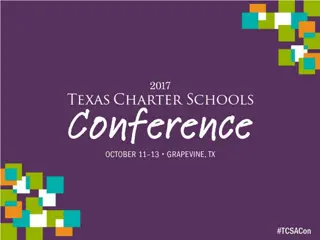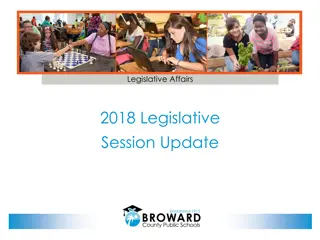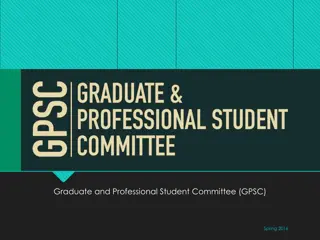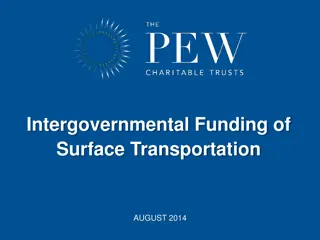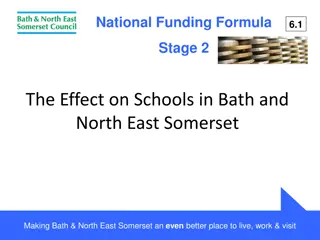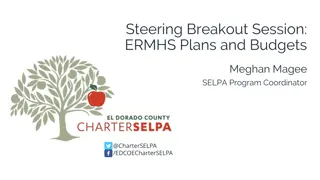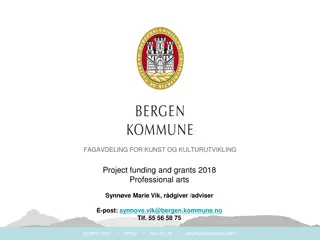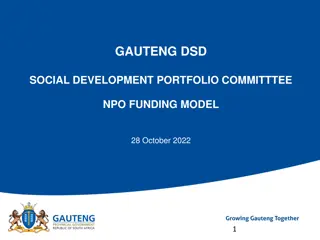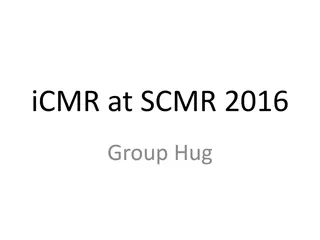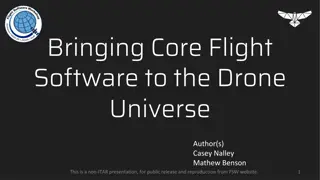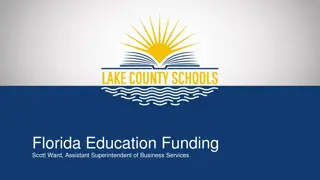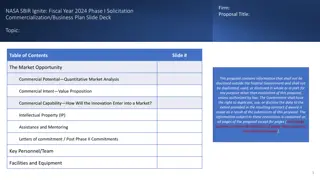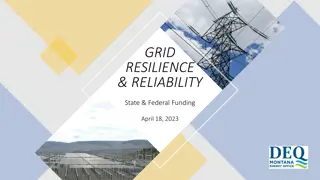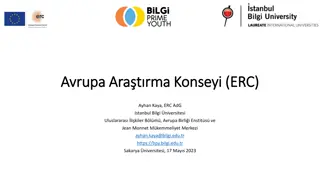Understanding SBIR and STTR Funding Programs
SBIR and STTR are funding programs supporting small businesses in commercializing innovative products. Founded in 1982, they have awarded billions to small businesses and stimulated technological innovation. The programs have three phases with specific rules to follow for funding eligibility. Universities and large companies can also participate in the program. SBIR program is set to expire in 2022.
Download Presentation

Please find below an Image/Link to download the presentation.
The content on the website is provided AS IS for your information and personal use only. It may not be sold, licensed, or shared on other websites without obtaining consent from the author. Download presentation by click this link. If you encounter any issues during the download, it is possible that the publisher has removed the file from their server.
E N D
Presentation Transcript
SBIR/STTR Funding Michael Tentnowski, Director of Entrepreneurship Innovation Park of Tallahassee
SBIR/STTR History Created by Roland Tibbetts at the NSF and signed in 1982 by Ronald Reagan SBIR programs awarded ~$40 billion to research-intensive small businesses 450,000 engineers & scientists involved; largest STEM talent concentration Meet Federal research and development needs Private-sector commercialization of innovations from Federal research Stimulate technological innovation Foster and encourage participation in innovation and entrepreneurship by socially and economically disadvantaged persons
Program Basics SBIR = Small Business Innovation Research STTR = Small Business Technology Transfer Nation s largest source of early stage / high risk funding Must be 51% American-owned, for-profit, and have <500 employees Must want to commercialize a product Retain the rights to intellectual property (in most cases) Awards based on; small business status, NAICS* codes, degree of innovation, technical merit, and future market potential * North American Industry Classification System
Three Phases & Rules Phase I Concept phase up to $225k, lasting 6-9 months (feasibility) Phase II After proof-of-concept up to $1.5M, and up to two years Phase III After Phase II to move from the lab to the marketplace, but must be private-sector funding NOT SBIR/STTR funded Principal Investigator (PI) Primarily employed by the small business and has overall responsibility for the project SBIR Small business must do at least 67% of the work, while a subcontractor can do up to 33% of the research STTR Small business must do at least 40% of the work, a Research Institution must do at least 30%, while a subcontractor can do the rest
SBIR SBIR Requirements You can include another company (large or small) and/or a university Subcontracting to a university or lab must be 33% or less of the work Investors may want SBIR rather than STTR because of University s claims Faculty sometimes prefer to participate as consultants, rather than as representatives of the University; know the Conflict of Interest policy SBIR Phase I recipients can win STTR Phase II awards and vice versa The SBIR program is slated to expire on Sept. 30, 2022
Agencies that Participate in the SBIR SBIR Program Department of Agriculture (USDA) Department of Commerce (DoC) Department of Defense (DoD) Department of Education (ED) Department of Health and Human Services (HHS) Department of Energy (DOE) Department of Transportation (DOT) Department of Homeland Security (DHS) National Aeronautics and Space Administration (NASA) Environmental Protection Agency (EPA) National Science Foundation (NSF)
STTR STTR Requirements Only 5 of the 11 participating federal agencies have STTR programs Up to 60% of subcontracting can go to research institutions Considered equal & collaborative partner status with universities/labs Chance of winning is greater when partnering with top-tier allies STTR Phase I recipients can win SBIR Phase II awards and vice versa The STTR program is slated to expire on Sept. 30, 2022
Agencies that Participate in the STTR STTR Program Department of Health and Human Services (HHS) Department of Defense (DoD) Department of Energy (DOE) National Aeronautics and Space Administration (NASA) National Science Foundation (NSF)
Agency Introductions: Dept. of Education: Phase I = $200k/8 mo. & Phase II = $900k/24 mo. Dept. of Energy: Phase I = $150k/9 mo. & Phase II = $1M/24 mo. Dept. of Health & Human Services: Phase I = $150k/6 mo. Phase II = $1M/24 mo. Dept. of Homeland Security: Phase I = $100k/6 mo. Phase II = $750k/24 mo. NASA: Phase I = $105k/6 mo. & Phase II = $600k/24 mo. (Phase II-E) NOAA: Phase I = $120k/6 mo. & Phase II = $400k/24 mo. NSF: Phase I = $225k/6-12 mo. & Phase II = $750k/24 mo. (+)
Department of Defense (DoD) Army: Phase I = $100k/6 mo. & Phase II = $1M/24 mo. Communications, Electronics, Engineering Services are the most funded projects Airforce: Phase I = $150k/9 mo. & Phase II = $750k/18-27 mo. Battlespace, Electronics, Sensors, Materials, Space Platforms are the most funded Navy: Phase I = $150k/? mo. & Phase II = $1M/? mo. (plus DTA $75k / $500k) Communications, Command, Control, Computers, Intelligence are the most funded CBD: Phase I = $150k/6 mo. & Phase II = $1M/24 mo. (plus DTA) Detection, Mitigation, Modeling, Simulation, Treatments are the most funded DTRA: Phase I = $150k/7 mo. & Phase II = unspecified Medical, Countermeasures, Modeling, Simulation are the most funded projects USSOCOM: Phase I = $150k/6 mo. & Phase II = unspecified Reconnaissance, Counterterrorism, Unconventional Warfare are the most funded
Small Business Registration Register with three databases right now (during the planning stage) D&B Dunn & Bradstreet (5 min.) Need: Employer Identification Number SAM System for Award Management (takes up to six weeks) Get: MPIN Marketing Partner Identification Number for future reference Small Business Administration - Company Registration (10 min.) FSU is already registered with these entities Additional requirements by agency: NASA Electronic Handbook HHS Grants.gov DOE Four additional systems NSF Fastlane (interactive real-time system) DoD Dept. of Defense Submission website
Required Registrations by Agency NASA x x x x HHS x x x NSF x x x DOE x x x DOD x x x DUNS SAM Company Registry (SBA.gov) Electronic Handbook (EHB) x x eRA Commons x Grants.gov x NSF FastLane x x Portfolio Analysis and Management System (PAMS) fedconnect.net Funding Accountability and Transparency Act Sub-award Reporting System x x DoD Submission Website
Winning Teams The Small Business Principal Investigator (PI) is the most important Show achievements, credentials and highlight experience Key Staff need bios, credentials and proven experience Subcontractors (agencies encouraged you to use them) Elevates credibility/prestige May discourage potential IP infringers Considered entities by solicitors Consultants May add experience, specialized talent, industry connections, etc. Considered individuals by solicitors
Solicitations; RFP, FOA, or Solicitation Unsolicited proposals are not accepted Usually between 30-200 pages (120 is typical) Three sections: Proposal Preparation Instructions Application & Submission Guidelines Evaluation Criteria Federal Fiscal Year is October 1st September 30th Cannot speak with topic authors after solicitation is released Can email authors on SITIS* but this will be made public There is a pre-release period (approx. one month prior) where you can communicate *SBIR Interactive Topic Information System
Release & Close Dates Dept. of Agriculture Release in June, Close in October Dept. of Commerce: NIST Release in January, Close in March NOAA Release in October, Close in January Dept. of Defense Release: April/July/Dec., Close: June/Sept./March Dept. of Education Release in December, Close in January Dept. of Energy Release: July/Oct., Close: in Oct./February HHS (NIH) Release in June, Close in Sept./January/April (grants) Dept. of Homeland Security Release in December, Close in January Dept. of Transportation Release in October, Close in December EPA Release in August, Close in October NASA Release in Mid-November, Close in Mid-January NSF Release in March/Oct., Close in June/December
Proposals Know the Evaluation Criterion Innovation Different than the state-of-the-art that is already out there Experience, Qualifications, & Facilities Team Commercialization Potential and merit Develop a Schedule Start now on the release date of the solicitation Allow for 10 weeks of preparation Formulate questions for TA (if allowed) Determine the structure: number of sections, page limit, font size, etc.
Sample 10-Week Schedule Week 1 Review topics and narrow down to one or two that fit well Week 2 Reach out to Topic Authors to gain insight and line up the team and internal reviewers of draft proposal(s) Week 3 Register in all databases; D&B, SAM, SBA Company Registration, agency-specific ones and conduct literature reviews Week 4 Add subcontractors, consultants, employees, partners Week 5 Create the financials; ask PTAP, SBDC, SCORE for assistance Week 6-8 Flesh out the remaining sections of the proposal Week 9 Provide a draft to colleagues, mentors, partners Week 10 Do not miss the deadline: submit the proposal two days prior
Proposal Preparation 40% of Phase I proposals are successful It takes between 40-60 hours to prepare a comprehensive proposal Include a commercialization plan Decision Timeline: 1 month for the agency to review the proposal 3 months for the scientific reviews (SMEs) 3 months until the award is announced Know your Technology Readiness Level (TRL 1-9)
Grants vs. Contracts Grants are flexible, so the PI has considerable latitude to deviate Applicants define the scope of work No legally-binding requirements to achieve results Payments are flexible; typically using a drawdown system Contracts are demanding, so the PI has limited latitude to deviate Scope of work is defined and inflexible Binding agreement to deliver for compensation Payments are based on milestones and deliverables All classified work is done using Contracts
Finding Opportunities Grants.gov for Grants only, not Contracts SBIR.gov and Zynsys.com are good for finding all solicitations Four step review of opportunities: 1. Make an honest assessment of the fit 2. Review any literature cited or references used 3. Establish a dialog with the Topic Author* to further explore fit 4. Consider whether other aspects of the proposal appeals to the agency * Also known as Topic Managers, Technical POCs, or Contracting Officer s Representative (COR)
Finding Small Business Partners Conferences and events: Careful selection of events is critical Review previous and/or current attendee lists Add all contact info from business cards into tracking system Send LinkedIn invitations to interesting contacts Send a brief email to continue the interaction Innovation Park is launching new programs: Ask for assistance in finding small business partners (Park network) Creating a database for matching-making small businesses with universities Hosting speed dating luncheons once a quarter
Conflict of Interest & Commitment A conflict of interest on the part of the faculty may arise when the faculty member is the co-founder, owner, or officer of the small business applying for funding, and will also do research under a subcontract between the small business and FSU Conflicts of commitment exist when individuals have difficulty balancing the effort necessary to perform their job duties while engaging in other activities that may or may not be job-related This type of conflict can also occur when an individual's research or work output is affected due to a competing influence Follow agency and institutional policies to manage, reduce, or eliminate such conflicts
Thank you! Michael Tentnowski Director of Entrepreneurship For a copy of the slides emailed to you: mtentnowski@inn-park.com
